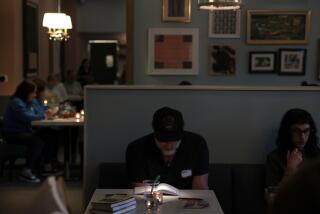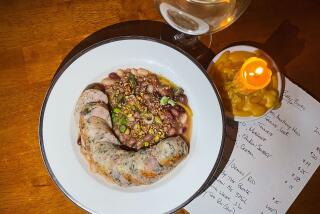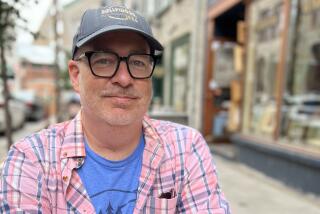Ernest Hemingway’s Paris springs to life via cafes, brasseries, more
PARIS — I was stalking Ernest Hemingway.
At least, it seemed that way. My travels had taken me to his house in Key West, Fla., still patrolled by descendants of his cats; to his childhood home in Oak Park, Ill.; and to the Compleat Angler, the raffish little hotel and bar (since destroyed by fire) on Bimini in the Bahamas, where he fished.
I even made it to Finca Vigía, his villa outside of Havana, now a museum, and scoped out his bars there — El Floridita, for daiquiris, and La Bodeguita del Medio, where he drank mojitos long before they became popular in the States.
MORE: Paris Museums to explore on a rainy day |Impressions of Monet’s Giverny | How to get there
Paris seemed conspicuous by its absence, and Woody Allen’s time-traveling “Midnight in Paris” put it in play. After all, hadn’t I been an English major? I should see where Hemingway had lived, written, scrimped, hoped, wandered and nursed café crème, beer, wine or whiskey with other writers, shouldn’t I?
Of course I should, and thankfully, my wife, Laurel, agreed.
Journey begins
By the time we settled into Hotel Henri IV, not far from Notre Dame Cathedral, more than nine decades had passed since the young Hemingway had arrived in Paris with Hadley, his first wife, and moved into Hotel Jacob et d’Angleterre to join an expatriate circle of writers and artists.
It had been about 25 years since Noël Riley Fitch published “Walks in Hemingway’s Paris,” an invaluable guidebook. Paris lacks a Hemingway museum that takes the strands of his life and weaves them together into a coherent narrative, so we created our own from various corners of the city.
We began where Hemingway had, walking the streets of the Saint-Germain-des-Prés neighborhood to his first residence, now called just Hotel d’Angleterre. In the lobby, we were immediately struck with buyer’s remorse.
Hotel Henri IV was fine, but we should have chosen the Angleterre.
Pictures in the lobby featured Hemingway, Ècrivain Américain (American writer), noting that on Dec. 20, 1921, he moved into chambre No. 14. If we ever return, we’ll ask for Room 14.
We found Ernest and Hadley’s first permanent home at 74 Rue du Cardinal Lemoine. My high-school French was just good enough to gather, from a plaque, that the couple had lived on the third floor from January 1922 to August 1923.
The scarred blue door suggested that, as modest as it might have been for a penniless fledgling writer, its lot in life, unlike Hemingway’s, never improved.
Humble no more
Just around the corner from the house, we stopped for coffee at La Chope at 3 Place de la Contrescarpe. This cafe lives on the site of the Café des Amateurs of Hemingway’s time. Hemingway liked watching the bustle of the quarter from here, and from our sidewalk table, so did we.
Just as people today linger with laptops at Starbucks for the price of a latte, Hemingway wrote and socialized in cafes, brasseries and bars. His recollections of these places are an evocative part of “A Moveable Feast,” a posthumously published memoir of his Paris years, and also figure into “The Sun Also Rises” and other novels as well as some short stories.
A favorite of his (but not ours) was Brasserie Lipp at 151 Boulevard Saint-Germain, where he would go for beer (brasserie means “brewery”) and a frankfurter, split and covered in mustard sauce. We headed there for lunch, but the place had gone seriously upmarket, as have many Hemingway haunts.
We took seats on the enclosed patio, looked at the stunningly expensive menu and ordered the small beers and the sausage that had lured us there — an appetizer, as our waiter grumpily pointed out.
The interior was all elegance, with mirrors and mosaics. Using a visit to the men’s room as an excuse, I breezed inside with my camera. As I pointed it, the maître d’ charged, waving his finger and saying “Non, non, non! The patrons don’t like it.” I slunk away.
We could eat or drink only so much, so we often just looked at (although sometimes slipping inside of) some of the surviving cafes and restaurants: Café de Flore, Le Pré aux Clercs, Le Dôme, La Closerie des Lilas.
Les Deux Magots was a must-enter. It was hard to imagine an impoverished writer today dawdling with pen (or electronic device) in hand at these now stylish and pricey spots.
Long walks
We wandered the narrow streets, passing apartments where Gertrude Stein, an early influence, and her partner, Alice B. Toklas, lived; where Hemingway’s great friend Sylvia Beach published James Joyce’s “Ulysses” and the site of Shakespeare and Company, her wonderful but now-gone English-language bookstore and lending library that opened in 1919.
Visiting the store’s namesake at 37 Rue de la Bûcherie, in the shadow of Notre Dame, was a highlight for me. George Whitman opened the bookshop in 1951 and gave it the Shakespeare moniker to pay homage to Beach’s store. It’s a wonderful rabbit warren of books that feels Hemingwayesque.
We loved walking along the Seine, as Hemingway did, browsing the bookstalls, admiring Notre Dame, floodlighted at night, and crossing the handsome Pont Neuf, then strolling in Luxembourg Gardens.
We took the Métro to Place de l’Opéra on the Right Bank to visit Café de la Paix, where newly arrived Ernest and Hadley splurged on a Christmas dinner. We looked inside — it’s part of the Intercontinental but has a separate corner entrance — then walked on to Harry’s New York Bar at 5 Rue Daunou (or Sank Roo Doe Noo, as a sign proclaims).
Dating to 1911, this saloon, a favorite of legions of writers, feels honestly old. I had a Bloody Mary (said to have been invented here), Laurel the anise-flavored pastis. The drinks were excellent, the atmosphere exceptional.
At Place Vendôme, we looked for the Ritz hotel, with its Bar Hemingway, which may be the closest thing here to a Hemingway memorial.
It wasn’t to be. The Ritz is closed for extensive renovations and is expected to reopen later this year; Bar Hemingway, I’m told, will be its old self.
The nearby Tuileries Gardens, where Ernest and Hadley also strolled, soothed our disappointment.
That evening we dropped in at Le Select, as Hemingway often did. Here the chatty barkeep gave us an extra splash of Hendrick’s gin, along with tapenade, peanuts and olives.
This seemed a spot where one could hang out to read, write, talk, drink. A clean, well-lighted place, I thought, recalling the title of a Hemingway story.
Our last Hemingway venture was dinner at nearby La Rotonde on 105 Boulevard du Montparnasse; cod aioli for Laurel, beef tartare for me.
“That was the end of the first part of Paris,” Hemingway wrote in the last chapter of “A Moveable Feast,” noting the closure of this formative episode of his life.
“Paris was never to be the same again, although it was always Paris and you changed as it changed.”
We felt the same.
More to Read
Sign up for The Wild
We’ll help you find the best places to hike, bike and run, as well as the perfect silent spots for meditation and yoga.
You may occasionally receive promotional content from the Los Angeles Times.






